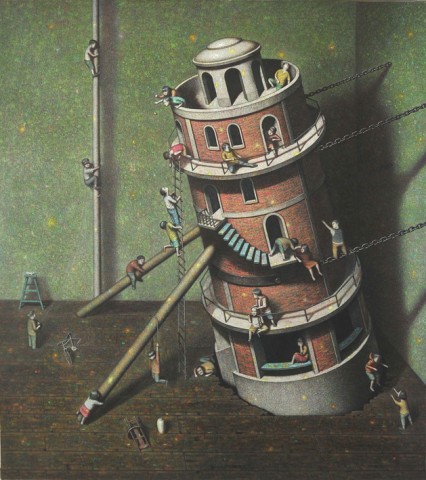
Raised in the 1970s, during the Cultural Revolution in China—which is described as a violent Communist purge of capitalism and tradition from 1966 to 1976—Liu Hong Wei spent much of his childhood at home, unable to go outside or attend regular school.
As a means of escape in his solitary environment, he fashioned a fantasy world, which would become the subject of his artistic career as an adult. Children are his main motif, shown engaging in different kinds of activities.
The stage-like settings with theatrical elements resemble the real architecture from the time the artist grew up. His scenes are often set within an interior space, but there is always a door or window that creates a passage to the outside world.
The children look enterprising and energetic. Taking things within their own hands, they work towards a positive future, eager to mend the mistakes of previous generations. In one fascinating piece, they attempt to rejuvenate a chunk of an old, dead tree.

There are no direct and loud Chinese symbols in the paintings but allusions are made to the country’s culture and social situation over the years. For instance, the early works of the artists reflect a time of poverty in China, when people lived with very limited resources.
As China goes through modernisation and urbanisation, the architecture changes. Its international interests are also reflected. Example, there is one piece with the Leaning Tower of Pisa. Furthermore, there are visual conversations with Western modern masters like Piet Mondrian and Joan Miró. Overall, Liu Hong Wei gives the viewer a vibe of hope, openness and progress that rests upon genuine effort and willingness—to repair wrongs and walk with the world.


The artist’s Hong Kong gallery Kwai Fung Hin states: “The paintings of Liu Hong Wei always look like scenes from a dream. In his works, people and objects of the real world are put into fabrications, not in accordance with the norms. Yet the depictions are fine and delicate, every scene on the canvas is fascinatingly alive. Therefore, he is drawing a world that is both distant from and close to us, in which familiar characters are playing absurd stories in a bizarre setting. His vision liberates our heart, changes our perspective and proposes infinite freedom from the known.
“The artist is leading the viewers to jump out of the box and to release themselves from their blind spots. He opens up a new horizon that invites us to deep introspection. There are no kitschy Chinese symbols in Liu’s works. There are indeed pulses of Chinese culture, but all subtly embedded. If we look more closely at his pictures, there are in fact such spontaneity and simplicity as typical of rural China everywhere on the canvas, as well as the discreet sophistication incarnated by the Chinese literati.
“Nor has Liu overlooked the impacts of dramatic changes on the present generation of the people in Mainland China, including their emotional flux, as well as their doubts about, or their hope in respect of, their future. In his works, there is no lacking of delicate and yet penetrating revelations and explorations on these subjects.

“There are no shouts of statement on contemporary issues in Liu’s works. He does, however, accurately perceive the anxiety and solitude in modern life, and is able to deal with such serious questions with a style of amazing ease. Play-like scenes are right there to offer release from and consolation for the weary and messy reality. Liu takes root in the environment in which he grew up. Blessed with outstanding insight and the ability to generalize, while drawing inspirations from a limited temporal scope, Liu manages to build a unique artistic realm with lasting impacts. His world is boundless.”
Kwai Fung Hin organised the first solo exhibition of Liu Hong Wei in 2000. Born in 1965 in Beijing, the artist graduated in 1988 from Hebei University, where he is a professor at the Academy of Arts and Crafts. His works have been collected by corporations and private collectors in mainland China, Taiwan, Hong Kong, USA, UK, France and Australia.
Links: Gallery website (www.kwaifunghin.com/artists/36-liu-hong-wei/overview)







—-
